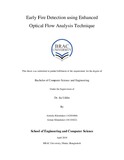Early fire detection using enhanced optical flow analysis technique
Abstract
This paper proposes a multi-stage fire detection model that consists of chromatic segmentation, shape analysis and differential optical flow estimation. At the initial phase, color segmentation is carried out which takes into account some of the existing state of the art color segmentation directives and employs a majority voting system among them to obtain the possible fire-like regions. The extracted sections are then passed onto a shape analyzer which verifies the authenticity of the candidate regions by inspecting the dynamics of shape. The distinctive change fire exhibits over time in its area-perimeter ratio is at the bedrock of this analyzer. Further evaluation is carried out by another analyzer that measures the turbulence of fire evaluated by an enhanced differential optical flow tracking algorithm. The Lucas-Kanade Tracking algorithm has been employed and extended to achieve this. The assessment of performance of the enhanced techniques was carried out by utilizing a versatile dataset containing videos from the MIVIA and Zenodo dataset. The dataset consists of a diverse array of different environments such as indoor, outdoor and forest fire. Some environments with no fire were also included to assess the rate of false positives. The model has successfully showed an improved accuracy of 95.62% when tested for the aforementioned dataset.

